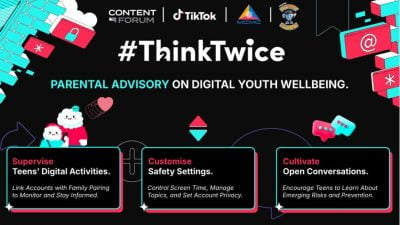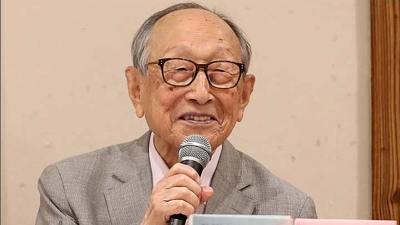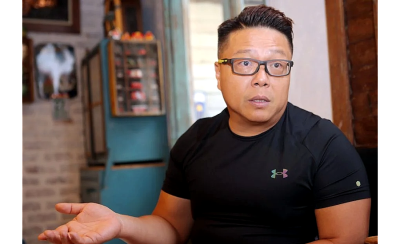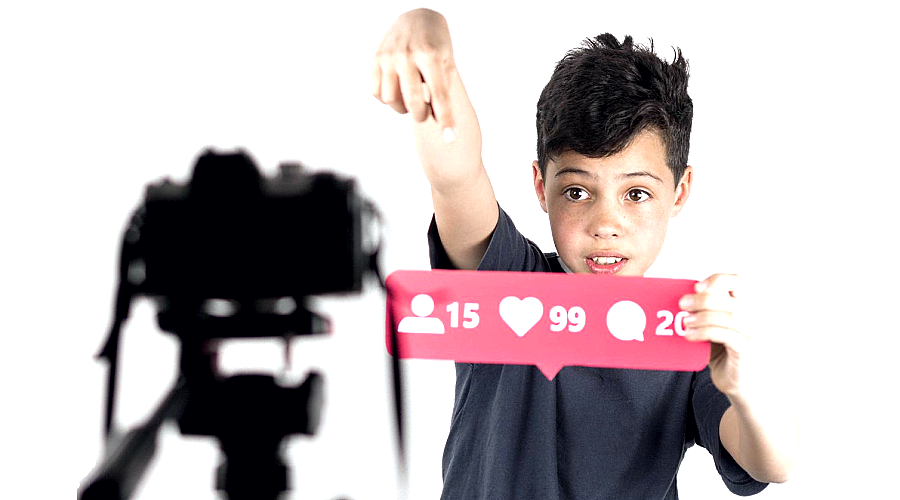
At seven years old, Isabelle is already on her way to becoming an online content creator.
She holds a bag of potato chips in her hands and kicks off the video recording by revealing its price and ingredients.
“Now, for the moment we’ve all been waiting for… the taste test,” says Isabelle as she presents to her classmates and teacher, pretending to tear open the bag and grab a chip.
Isabelle describes the taste as “an explosion of flavour” with a smile on her face, ending the presentation with the tagline, “Snack on, friends!”
Johan Ooi, co-founder and public speaking instructor of Johan Speaking Academy, whispers: “She’s pretending because her mum doesn’t want her to eat too many snacks during class.”
On a Saturday morning in Kuala Lumpur, she is one of six students attending a class to learn the art of product reviews.
In an era where kids mostly consume content online, Ooi noticed a growing interest among his students in becoming content creators.
Responding to their feedback, he decided to incorporate product reviews into his public speaking class modules.
“Back then, kids would say their dream jobs were to be a lawyer, doctor or engineer. Now, a popular answer would be YouTuber.
“Recently, some also said, ‘Teacher, I want to be a TikToker,’” Ooi says, attributing it to the popularity of online streamers like Ryan Kaji of Ryan’s World (formerly Ryan’s ToysReview) and Blippi.
Over the course of two months, the students, ranging in age from six to 12 years old, will gather on weekends to learn fundamental aspects of content creation, like devices for vlogging and simple tools for editing.
They start by selecting their preferred item, whether it’s a book, toy or food, before learning to prepare a script, with the end goal of being able to present without having to read from one.
“It’s about building up their confidence to speak to an audience. At the end of the lesson, the students have to do a presentation for their parents, who would like to see how far they’ve come since the first session,” Ooi says.
Streaming strategy 101
At KL-based Kidocode, its YouTube Engineering course has been attracting about 20 to 30 students each week since it was introduced in 2019.
Founder Hossein Tohidi says that the beginner level, which covers idea generation, recording equipment setup, and content promotion, may require up to 50 hours to complete.
“The essence of becoming an effective content creator starts with learning how to be a good storyteller. We teach them how to do their research and use AI (artificial intelligence) tools like ChatGPT in the process.
“They must also learn how to verify the information they get,” Hossein says.
In advanced-level classes, students delve into sound editing, digital animation, and video editing to broaden their skill set.
Hossein emphasises that aspiring content creators must recognise the importance of not only mastering editing and production but also gaining an understanding of the creator economy.
“It’s important that we help the students understand how to create engaging content. They need to establish KPIs (key performance indicators) to measure the success of their content,” he says.
Hossein, also a computer scientist, says mathematics and coding will also be incorporated into the lessons.
“When they go into this course, they have to understand a little bit of statistics to see things such as the normal distribution and then use the Python programming language to create a diagram for analysis,” he says.
Hossein says this will help the students identify the best day of the week to post new content.
“It may seem intense at first, but the students love it,” he says, adding that they are between seven and 18 years old.
One of the students, Arsham Ali Shirkouhi, 18, shares that he enrolled in the course as a side interest while pursuing a computer science degree at a university.
“I started a channel where I mostly do videos about computer science. I also started making non-computer science-type videos where I talk about gaming, and I find those videos get more views.
“It’s inspired me to think about how I can do different kinds of videos to appeal to more viewers,” he says.
Nur Atiqah Ahmad, CEO and co-founder of Creative Sandbox, notes that parents today have become increasingly supportive when their children express an interest in becoming content creators.
Parents have approached her for advice on starting a channel for their kids, while those who already have a channel sought guidance on developing more content.
At her creative multimedia and digital arts academy, Nur Atiqah offers a range of classes catered to children interested in learning content creation, including the four-day Digital Creator Intensive programme usually held during school holidays.
“Instead of just consuming content, some parents want to take it a step further and see their children be the ones producing the content instead,” she says at an interview in Cyberjaya.
The lessons start with Nur Atiqah assisting students in generating ideas for video projects based on their individual interests.
“Younger students will be interested in making stop-motion-style videos or sharing information about their interests. For example, one child wanted to talk about sharks,” she says.
Students in secondary school, on the other hand, prefer content that showcases aspects of daily life, such as interactions with friends.
“They like to interview friends and do ‘what’s in my bag’ type of videos. It mostly depends on the type of videos that they like to watch,” she says.
Whatever their interests, Nur Atiqah says her goal is to steer them towards making content that would be beneficial to viewers.
“I think it’s important that we start having conversations about being responsible content creators from an early age.
“They must be aware of the content they are making and how it will impact their audience,” she adds.
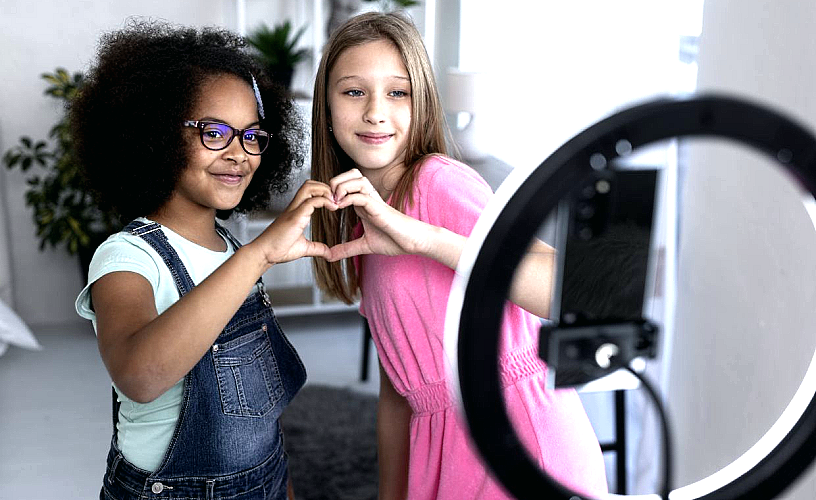
Facing the facts
In recent years, young individuals have increasingly viewed the idea of online content creation as a viable career path.
A survey in 2019 of 3,000 kids in the United States aged between eight and 12 found that 29% preferred becoming vloggers or YouTubers over other career options such as teacher, professional athlete, musician and astronaut.
In March, the USCI Poll Research Centre conducted a study involving 1,000 SPM leavers aged between 18 and 20 years old to discover their future plans.
The study found that nearly half of the respondents were not interested in furthering their education after SPM.
Of the 490 students, a majority or 34%, wanted to pursue a career as a social media affiliate or influencer.
The motivation could stem from a desire to make money, as Hossein has observed that it is common for a child to express on the first day of class, “I want to be a YouTuber so I can be super rich.”
Ooi highlights a similar sentiment, adding, “I think there’s a perception among children that becoming a YouTuber or doing content creation is easy, and they can earn a lot of money in the process.”
However, it doesn’t take the kids long to realise that it may not be all fun and games.
“Initially, they find shooting fun. But eventually, the kids find out on their own that being a content creator is not as easy as it looks,” Ooi says.
The children, he says, mostly found editing to be challenging as they needed to spend more time adding transitions and subtitles. Some couldn’t complete the work due to their parents allowing them limited screen time at home.
“They would come to class and ask us to complete the editing for them. Eventually, we reworked the programme to focus on other skills that they would be happy to do, such as presenting,” Ooi says.
Nur Atiqah says that if the students don’t enjoy a particular role, say, being in front of the camera, she would encourage them to take on other functions.
“Some children enjoy editing or handling digital animation instead. They feel more comfortable being behind the camera and supporting their friends,” she says.
Beyond the lessons in the classroom, according to Ooi, there are other challenges that children have to be prepared for, such as how to navigate negative online comments.
“We don’t hide the kids from the reality that they will see all kinds of negative comments online. We also tell the parents that there are keyboard warriors with nothing to do who will create issues.
“These comments should not dictate their lives,” Ooi says, adding that parents and children have to work closely together to overcome negativity on social media.
Hossein advises his students never to perceive receiving a negative comment online as a failure.
Instead, he stresses that setbacks are part of the learning process, and they should focus on taking constructive feedback to overcome challenges.
“It’s like when you’re building a program and you encounter bugs, you just have to find ways to fix them.
“If we raise our children to consider failure as an outcome but not part of the process, then they will never be prepared for the real world,” he says.
Sellable skills
Through exposure to learning how videos are made, Hossein says his students will develop a better appreciation for the content they watch online.
“They become aware of how much effort some creators put into their videos. We encourage our students to always leave positive or constructive comments on other people’s work that they see online.
“This helps to foster better online social habits and opens up avenues for them to collaborate with each other,” he says.
Meanwhile, Nur Atiqah says even if the students don’t end up becoming content creators, they now have added skills that could be applied in other aspects of life.
“You could end up in a corporate field with content creation as an added skill,” she says, pointing out that content creation is not limited to just influencers as there is a growing number of professionals like doctors and lawyers who are also doing videos online.
Ooi is of the belief that parents should have the final say as to the creation and management of the channel and what is uploaded.
He adds that it’s also up to parents to keep up and be aware that children are capable of learning to use social media on their own.
Ultimately, he encourages parents to find a way to enjoy the process of content creation with their children.
“As much as parents want to feel like they should be teaching their children, they should also be open to learning from them.
“I am also learning something new from them every day when it comes to technology,” he says.

ADVERTISEMENT
ADVERTISEMENT









